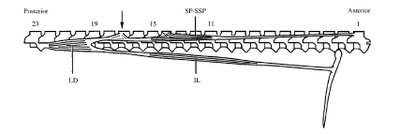Snake Biology - A VERY Brief and Incomplete Overview
Snake Biology
Physiology
It is the physiological attributes of a snake that allow for the above advantages to be evident. At all times, it must be understood that:
1. All snakes have between 100-400 vertebrae, and most have over 200.
2. For each vertebrae there are two ribs
3. Each muscle is attached to both multiple vertebrae and a rib.
4. A snake’s skin can slide easily only in one direction.
200+ Vertebrae
Snakes, regardless of the overall outer dimensions, usually possess greater than 200
vertebrae. Each vertebrae connects to it’s adjoining vertebrae directly though cartilage that limits the amount of flexion and rotation each vertebra can achieve.
The smallest bends of a snakes body can use anywhere from 20 to 100 vertebrae. Moon studied the twisting angle between single vertebrae of the snake by measuring the distance of dots painted on the skin above a snake’s vertebrae and measuring their distance from the midline during a twisting motion. He concluded that each vert is capable of 1-2 degrees of rotation. While this seems insignificant, the fact that a snake may use from 20-100 vertebrae in a single undulating bend, means that over 20 degrees of twist are possible. This twist may be responsible for the cam-type motion describe by Gasc & Moon.
Ribs
For every vertebrae, there are two ribs that give the surrounding musculature a skeletal frame for structural support. The ribs are a crucial element for a snake’s movement as they provide intrasnake manipulation of muscle and organ placement.
Muscular Attachment
Figure 1 shows the typical muscular attachment for the common gopher snake. It can be seen from the figure that a single muscle group connects the 1st, 14th, 17th, and 23rd vertebrae. This provides the ability for a streamlined muscular system to surround the skeletal system and provide structural support. This muscular attachment is the key in providing a snake with mobility.

Also note that, contrary to most actuated robots today, the actuating mechanism does not connect directly or solely to the next link in the kinematic chain.
Snake Skin
The skin of a snake has the remarkably simple property of providing a low-friction coefficient in a single direction. This is due to the shape and texture of the scales on snake skin. This feature of snake skin provides the snake with the ability to perform multiple types of movement.
Figure 2 shows a snake skin micrograph. The picture is taken in a parallel direction to the snake. The dark areas represent the scale and it’s muscular attachment. We can see that when the skin is tensioned laterally, it will stretch almost 100% its original width. In the longitudinal direction, the amount that snakeskin can be stretched is negligible.

Physiology
It is the physiological attributes of a snake that allow for the above advantages to be evident. At all times, it must be understood that:
1. All snakes have between 100-400 vertebrae, and most have over 200.
2. For each vertebrae there are two ribs
3. Each muscle is attached to both multiple vertebrae and a rib.
4. A snake’s skin can slide easily only in one direction.
200+ Vertebrae
Snakes, regardless of the overall outer dimensions, usually possess greater than 200
vertebrae. Each vertebrae connects to it’s adjoining vertebrae directly though cartilage that limits the amount of flexion and rotation each vertebra can achieve.
The smallest bends of a snakes body can use anywhere from 20 to 100 vertebrae. Moon studied the twisting angle between single vertebrae of the snake by measuring the distance of dots painted on the skin above a snake’s vertebrae and measuring their distance from the midline during a twisting motion. He concluded that each vert is capable of 1-2 degrees of rotation. While this seems insignificant, the fact that a snake may use from 20-100 vertebrae in a single undulating bend, means that over 20 degrees of twist are possible. This twist may be responsible for the cam-type motion describe by Gasc & Moon.
Ribs
For every vertebrae, there are two ribs that give the surrounding musculature a skeletal frame for structural support. The ribs are a crucial element for a snake’s movement as they provide intrasnake manipulation of muscle and organ placement.
Muscular Attachment
Figure 1 shows the typical muscular attachment for the common gopher snake. It can be seen from the figure that a single muscle group connects the 1st, 14th, 17th, and 23rd vertebrae. This provides the ability for a streamlined muscular system to surround the skeletal system and provide structural support. This muscular attachment is the key in providing a snake with mobility.

Also note that, contrary to most actuated robots today, the actuating mechanism does not connect directly or solely to the next link in the kinematic chain.
Snake Skin
The skin of a snake has the remarkably simple property of providing a low-friction coefficient in a single direction. This is due to the shape and texture of the scales on snake skin. This feature of snake skin provides the snake with the ability to perform multiple types of movement.
Figure 2 shows a snake skin micrograph. The picture is taken in a parallel direction to the snake. The dark areas represent the scale and it’s muscular attachment. We can see that when the skin is tensioned laterally, it will stretch almost 100% its original width. In the longitudinal direction, the amount that snakeskin can be stretched is negligible.


0 Comments:
Post a Comment
<< Home